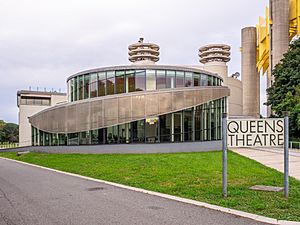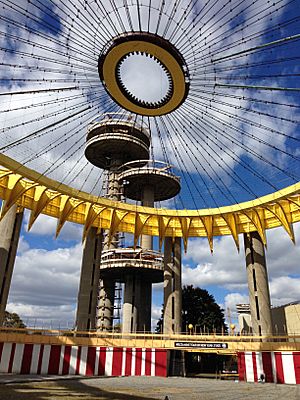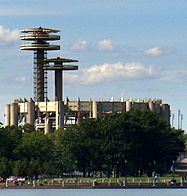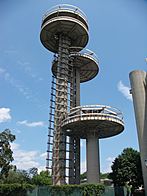New York State Pavilion facts for kids
Quick facts for kids |
|
|
1964-1965 New York World's Fair New York State Pavilion
|
|
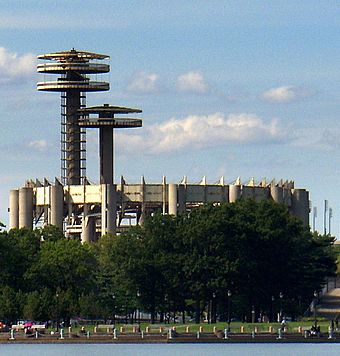
Seen from Meadow Lake
|
|
| Location | Flushing Meadows–Corona Park, Flushing, New York |
|---|---|
| Area | less than one acre |
| Built | 1962–1964 |
| Architect | Philip Johnson and Richard Foster, structural engineer Lev Zetlin |
| NRHP reference No. | 09000942 |
| Added to NRHP | November 20, 2009 |
The New York State Pavilion is a cool old building in Flushing Meadows–Corona Park in Flushing, Queens, New York. It was built for the 1964 New York World's Fair by famous architects Philip Johnson and Richard Foster, with engineer Lev Zetlin. It's a historic landmark that many people still visit today.
Contents
Exploring the Pavilion's Design
The New York State Pavilion has three main parts. These parts are built from strong materials like reinforced concrete and steel. They are called the "Tent of Tomorrow," the Observation Towers, and "Theaterama."
The Tent of Tomorrow
The "Tent of Tomorrow" is shaped like a giant oval. It has sixteen tall concrete pillars, each 100 feet (about 30 meters) high. These pillars once held up the world's largest cable roof. A cable roof is like a giant tent held up by strong cables.
The main floor of the Tent was a huge map of New York State. It was made from terrazzo, a special floor material with colorful chips. This map showed all the highways in the state.
The Observation Towers
The Observation Towers are three concrete towers that stand next to the Tent. The tallest tower is 226 feet (about 69 meters) high. The towers have platforms where people could once look out over the fair.
Visitors used to ride special "Sky Streak capsule" elevators to reach these platforms. These elevators are no longer there. The shortest tower's platform is 85 feet (about 26 meters) high, and the middle tower's platform is 160 feet (about 49 meters) high.
Theaterama
"Theaterama" was originally a round, drum-shaped building made of concrete. It has been changed and updated over the years. Today, Theaterama is home to the Queens Theatre.
The Queens Theatre is a place where you can watch plays, dance shows, and special programs for kids and families.
The Pavilion After the Fair
After the 1964 World's Fair ended, the New York State Pavilion was one of only two buildings kept. The other building, the U.S. Pavilion, was later torn down.
A Star on Screen and Stage
The New York State Pavilion became a popular spot for movies and TV shows. You might have seen it in an episode of McCloud or in the movie The Wiz. It was also a key part of the movie Men in Black. The pavilion even appeared as the Stark Expo in Iron Man 2.
It also hosted big rock concerts in 1969. Famous bands like Led Zeppelin, the Grateful Dead, James Brown, and Santana played there. The band They Might Be Giants filmed their music video for "Don't Let's Start" at the pavilion in 1987.
Years of Neglect
For many years after the fair, the pavilion was left empty and uncared for. Its roof was gone, and the colorful floors and walls faded away. In the late 1970s, the red ceiling tiles were removed for safety. This left the special terrazzo floor open to the weather, and it was ruined.
In 1994, the Queens Theatre moved into the building next to the towers. They still use the old pavilion for storage.
A Rare Glimpse Inside
For the 50th anniversary of the World's Fair, on April 22, 2014, the pavilion was opened to the public for a few hours. Because the building was old and worn, visitors had to wear hardhats.
More than 5,000 people came to see inside the Tent of Tomorrow. On that same day, the National Trust for Historic Preservation named the pavilion one of America's "National Treasures."
Efforts to Restore the Pavilion
People have been working to save and fix the New York State Pavilion. In 2008, researchers from the University of Pennsylvania showed how the building could be repaired. Some local groups are also trying to raise money to fix the terrazzo floor.
In 2009, the pavilion was added to the National Register of Historic Places. This list helps protect important historic sites.
Plans for a Brighter Future
In 2013, the New York City Department of Parks and Recreation announced plans to restore the pavilion. They planned to add new paths and spaces for events. This would cost about $73 million, which was less than it would cost to tear the building down.
Interest in fixing the pavilion grew in 2014, for its 50th anniversary. In July 2014, the pavilion received about $5.8 million for repairs. The New York Mets baseball team also donated money. Sadly, the pavilion was damaged by arsonists that same month.
In May 2015, a group of steel painting contractors and union workers started a project. They decided to repaint the rusty steel frame of the Tent of Tomorrow. They chose a color called "American Cheese Yellow" because it matched the original color. Most of the work was done by trainees, and the materials were donated. This was like a $3 million gift! All the painting was finished by August 2015.
In 2018, two new designs for the pavilion's restoration won awards. The New York City government planned to start new restoration work in May 2019, costing $14.25 million. This work began in November 2019 and was expected to finish in early 2021.
The Pavilion in Pop Culture
Movies and TV Shows
In the 1997 movie Men In Black, the round observation decks are shown as secret flying saucers. The movie suggests the 1964 World's Fair was a cover for aliens to land on Earth. A ride at Universal Studios Florida called "Men in Black: Alien Attack" has a copy of the two tallest observation decks.
The pavilion is also the main topic of a documentary film. It's called Modern Ruin: A World's Fair Pavilion, made by filmmaker Matthew Silva. The movie first showed on May 22, 2015, at the Queens Theatre, which used to be the Theaterama building.
Video Games
The New York State Pavilion has appeared in video games too. It was featured in the 2008 game Grand Theft Auto IV. It also shows up in Skate 3 as part of a special download pack, with a concrete skatepark inside the structure.
Ideas for the Future
In March 2016, two groups, People For the Pavilion and the National Trust for Historic Preservation, started a competition. They asked people from all over the world to share their ideas for what the pavilion could become in the future.
Images for kids


